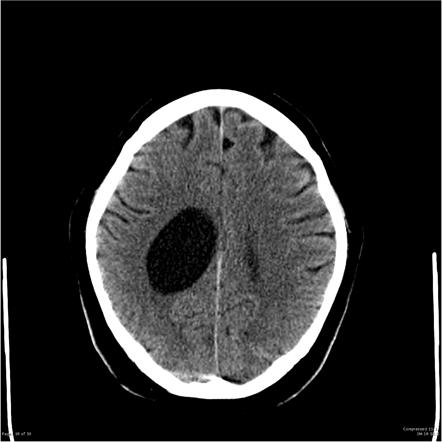


A brain cyst is a fluid-filled sac or lesion that forms within the brain tissue or in its surrounding membranes. The cyst is mostly benign, which means it does not lead to any cancer but can affect the daily routine of an individual in ways such as headaches, vision problems, nausea and vomiting, seizures, and many others.
The intraventricular cyst is a condition in which the development of cysts occurs within the brain ventricles.
Ventricles are the cavities in the brain that are responsible for the production and storage of cerebrospinal fluid. CSF is a watery fluid that surrounds your brain and spinal cord and also helps provide cushioning and protection from any trauma. It also removes waste and provides nutrients to your brain.
When a cyst develops in any of the ventricles, it can disrupt the cerebrospinal fluid’s normal flow and functioning, leading to various potential complications.

A colloid cyst is a type of brain cyst that typically develops in the third ventricle of the brain. The third ventricle is one of the four interconnected cavities within the brain responsible for cerebrospinal fluid (CSF) circulation. Colloid cysts are filled with a thick, gel-like substance called colloid material. While these cysts are generally considered benign, they can cause problems by obstructing the normal flow of cerebrospinal fluid.
The causes of intraventricular cysts are still unknown and can vary from person to person. It is believed that some cysts are congenital, i.e., present at birth due to some fetal abnormalities, and others may be acquired later in life, like head injuries, inflammation within the brain, and infections.
Signs and symptoms of an intraventricular cyst include persistent headaches that worsen over time, blurred or double vision, changes in mood and behaviour, and difficult concentration and coordination issues.
Treatment options for intraventricular cysts are considered when the cyst in the ventricles may press the brain tissue and cause symptoms or when it becomes enlarged. Treatment is also recommended when the cyst blocks the normal flow of cerebrospinal fluid.
Neuroendoscopy is a minimally invasive surgical procedure that is used to treat intraventricular cysts that develop in the brain’s ventricles. Under neuroendoscopy, several treatments are classified based on the type, characteristics, and location of the cyst. It also depends on the patient’s overall health, and below are some of the surgical options that use neuroendoscopy to treat intraventricular cysts.

One of the best and most effective treatments for intraventricular cysts is endoscopic cyst fenestration. It is a minimally invasive procedure that includes creating an opening, also known as fenestration, in the cyst while using an endoscope.
During this surgical procedure, the surgeon inserts the endoscope into the ventricles to help doctors look out the cyst and carefully create an opening in the cyst. Creating the opening in the cyst, allows the cyst’s contents (cerebrospinal fluid) to drain into the surrounding ventricle or brain tissue.
2. Cyst resection
There are different types of intraventricular cysts, and so there are treatments. It is necessary to completely remove the solid and thick-walled intraventricular cyst.

For this, surgeons choose the neuroendoscopic cyst resection method. This surgical method involves using an endoscope to carefully visualise the cyst and dissect it from the surrounding tissue.
After removing the cyst, the patient will not experience any symptoms or complications associated with the cyst.
3. Endoscopic Third Ventriculostomy (ETV)
This procedure is performed when the intraventricular cyst interferes with the flow of the cerebrospinal fluid within the ventricles. During ETV, doctors, by using an endoscope, create an opening in the floor of the third ventricle that helps allow the fluid to bypass the cyst and resume its normal functioning.

Neuroendoscopy for intraventricular cysts offers several benefits such as less invasive, shorter recovery period, and hospital stays as compared to traditional surgery.
4. Endoscopic Excision of Colloid Cysts
One of the most advanced and minimally invasive methods for excising colloid cysts is through neuroendoscopy. Here’s how the procedure typically works:

An intraventricular cyst is usually a benign cyst, but it can also lead to some discomfort and complications in individuals. To help alleviate the discomfort of people dealing with this problem, surgeons use specific approaches and techniques involving neuroendoscopy. It is important to consult a skilled neurosurgeon with extensive experience and specialising in neuroendoscopy.